Burnett of Leys - Scotland
Italiano

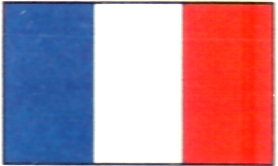
 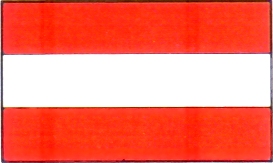
 
| 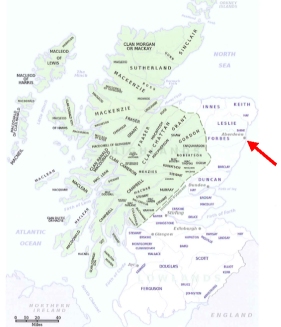 Quando: XIII secolo
Quando: XIII secolo
Dove: Banchory in Aberdeenshire,
nel nord dell’ isola della Gran Bretagna e precisamente in Scozia;
Chi: i Leys possiedono in questa
zona (da quando?) un territorio con un piccolo laghetto al cui
interno esiste una piccola isola (oggi il laghetto è stato prosciugato
e il tutto si presenta come un avvallamento con all’interno
un promontorio);
Avvenimenti:
Edoardo I d’Inghilterra vuole sottomettere con le armi la Scozia,
ma Robert Bruce ( 11.7.1274 – 7.6.1329) conosciuto come Robert
I re di Scozia (dal 1306 al 1329) combatte per l’indipendenza.
La famiglia (Clan) Burnett è alleata con Robert I e da lui nell’anno
1323 riceve in dono le terre dei Leys (anch'essi alleati di
Robert I ma deceduti in battaglia senza eredi?)
Le terre vengono donate da Robert I alla famiglia Burnett, ma
il cognome Leys non cessa di esistere forse per volere di Robert
I, o per desiderio della famiglia Burnett, od entrambe le cose?
Per motivi ad oggi sconosciuti (2010) la famiglia Burnett decide
di non eliminare il cognome Leys, forse nel ricordo e per rendere
onore a fidi compagni per l’indipendenza e deceduti in battaglia?
Qualsiasi sia la ragione storica, dal 1323, tutti i discendenti
diretti si chiameranno Burnett di Leys, come fu a partire dal
capostipite Alexander Burnet of Leys, married Janet Gardine-
da Burnett Family Genealogy.
|
|
Ringrazio sentitamente James
C.A. Burnett of Leys per le risposte a tutte le
mie domande ed inserisco la mail.
Visitate il sito www.burnett.uk.com
e sfogliate il libro seguente per ulteriori
approfondimenti
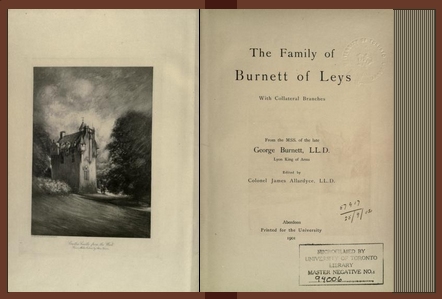
property
of www.burnett.uk.com
|
|
-----
Original Message -----
From: James Burnett
To: Leis@quipo.it
Sent: Saturday, June 12, 2010 9:47 AM
Subject: FW: Leis-leys Inghilterra
Dear Ilaria
Thank you for your inquiry, (for which I assume you were directed
via www.burnett.uk.com ) but I regret that I may not be able to
give you much useful information. However, I have added some notes
to your questions below which may be of interest
Whether or not we are related, I cannot say. If not proved, we
use the expression “indeterminate”. Regardless, I can include
your website as a link on ours. Best wishes
James C.A. Burnett of Leys
--------------------------------------------------------------------------------
From: Leis_il_Sito [mailto:Leis@quipo.it]
Sent: 11 June 2010 07:33
...
Subject: Fw: Leis-leys Inghilterra
Importance: High
Dear Sirs,
my grandmother's surname was Leis. I created a free educational
website to simply let other people know about the informations
I collected with my father.
I'd like to add some informations about You to my site, after
Your confirmation. I'd like to solve some doubts indeed, before
I'll publish these informations on my site. I've read Yours.
Here are some questions to You, if You could answer them.
- Is the surname Burnett of Leys derived from a place or is the
place that took name from the surname (analogy by Wien - Vienna
or by Laimburg - Leys von Laimburg)?
{The designation of Leyis is met in 1446
for the first time – (Leys in charters from this date onward)
and most specifically to lands adjoining the Loch of Banchory
and which is since known as the Loch of Leys. I have always assumed
that the word means land and possibly low lying land}
- If the place was called Leys, do You know when to town/place
was founded or first cited in historical documents? {
as above}
- If not like above, when was the first Burnett of Leys there
and gave the name to this place? {The first
Burnett was John Burnet of Leyis and since when the surname became
less uniform – Burnat, Burnate, etc}
- Why have You got both a coats of arms and a crest? Why are they
not similar?
- Are grapes and vine cultivation common in Your district or do
You mean, is this a symbol? Is the knife in Your symbol typical
of Your country/family or is it simply a citation of those used
in ancient times?
{A full achievement of Arms in Scotland
consists of a shield, helmet, mantling, crest, and motto. For
certain people added to these are supporters on either side of
the shield. What is on the shield is the principal device. The
crest is additional, but not essential. Many people have recorded
Arms without a crest.
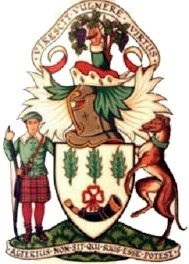 The principal purpose of Arms was one of identification, especially
on the field of battle. The importance attached to being seen
is not clearly understood unless it is appreciated that it was
more useful to capture and ransom a person of note than to kill
him. Drawing attention to oneself was often unlikely to be fatal.
The principal purpose of Arms was one of identification, especially
on the field of battle. The importance attached to being seen
is not clearly understood unless it is appreciated that it was
more useful to capture and ransom a person of note than to kill
him. Drawing attention to oneself was often unlikely to be fatal.
The Coat-of-Arms shows the Horn of Leys which was given to Alexander
Burnard in 1323. The origin of the Holly Leaves, the plant-badge,
is unknown. It is commonly thought to reflect Alexander’s association
with the Royal Forest of Drum. However, this is unlikely to be
correct since similar leaves existed on earlier family seals.
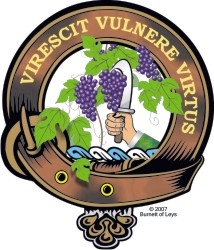 My crest is purely symbolic and nothing to do with growing grapes
in Aberdeenshire! It shows that the vine is improved by pruning
to encourage growth and the motto translates as “Strength draws
vigour from an injury”. This is a sentiment which obviously appealed
to the first Burnett of Leys who decided to make it his motto,
had he been beset by trying circumstances at the time?}
My crest is purely symbolic and nothing to do with growing grapes
in Aberdeenshire! It shows that the vine is improved by pruning
to encourage growth and the motto translates as “Strength draws
vigour from an injury”. This is a sentiment which obviously appealed
to the first Burnett of Leys who decided to make it his motto,
had he been beset by trying circumstances at the time?}
Thank You a lot.
If You want to add any informations, I'll thank You. You'll surely
get the link to the page, when I'll create it, and I'll correct
the informations, if You'll send me feedback.
My site is
http://utenti.quipo.it/Leis/
Best regards
Ilaria Ferrari |
|
[Texto
en español - las imágenes son anteriores]

Lsa
D4.

[Texte
en français - les images sont au-dessus]

T
T.

[Text
auf Deutsch - die Bilder sind oben]
 
T
T.

[Text
in English - the images are above]
 
Leys - England
When: 13 th century.
Where: Banchory in Aberdeenshire, in northern Great-Britain, more precisely in Scotland (check Wilkipedia map : Scottish Clan ).
Who: one or more persons by the last name of Leys owned in this area ( since when ? ) a land with a little lake and the little island inside (up today the lake has dried up and the area is a valley with a promontory).
Events:
Edward I of England wants to submit Scotland using weapons, but Robert Bruce (11.07.1274 - 07.06.1329), known as Robert I king of Scotland (from 1306 to 1329) fights for indipendence.
The family (also called CLAN) Burnett becomes allies with Robert I in 1323, and receives the lands of the Leys as a donation (it's unknown if the Leys were a family too end if they were also allies with Robert I, but died during the battles and/or with no heirs).
The lands are donated by Robert I to the Burnett family, but the name Leys never expired; it's not clear if by will of Robert I, by wish of Burnett or both.
For reasons that are still unknown today (2010), the Burnett family decides not to erase the name Leys ( in memory and honor of companions in the fight for indipendendence deceases in battle ? )
In any case, after 1323 all direct descendants are called Burnett of Leys, like Alexander Burnet of Leys, married to Janet Gardine of the Burnett Family Genealogy.

|
|